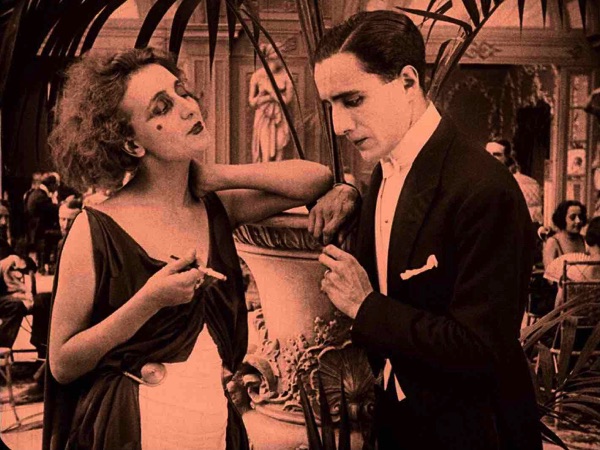FIORE SELVAGGIO
Gustavo Serena (IT 1921)
Between 1916 and 1922 Anna Fougez (1894-1966; original name Maria Annina Pappacena), a child prodigy and variety star born in Taranto, tried her hand at a new art form. In those few years she acted in seven films, fitting them around her constant schedule of theatre engagements. The young singer and dancer was signed by Cines for the comedy Le avventure di Colette (R. Savarese, 1916), but her film debut was unsatisfactory. When she returned to the screen, in 1919, she became the top actress in Rome for Filmgraf and Libertas Film, who featured her in special series of passionate and tragic dramas, such as L’immagine dell’altra, L’ultima recita di Anna Parnell, La vita e la leggenda (all 1919), Fiore selvaggio, Senza colpa (both 1921), and Il fallo dell’istitutrice (1922). At her side was Gustavo Serena, in the dual role of artistic director and second lead, who formed a partnership with her, as he had with Francesca Bertini from the time of the production of Assunta Spina (1915) to 1919.
Of the films featuring Anna Fougez the sole survivor today is Fiore selvaggio (literally, Wild Flower), the only visual testimony of the star’s acting temperament and a certain spontaneity and at times even freedom from the excesses expected of most divas of the time. It is also the only film for which Fougez wrote the story, which she signed with the pseudonym “Anna Lagez” – another reflection of her character, which, in the urgent desire to exhibit her versatility, gave life to a multi-faceted woman and unlikely adventures.
At the beginning of the story Anna is a wily shepherd girl who is noticed by Ugo, a promising musician who has returned home to his village in search of inspiration. An orphan, she manages to get taken into his family, where Ugo grows close to her and personally takes care of her education. The budding relationship between the two is discovered by his old mother, and the couple is sent away. Anna follows Ugo, becoming his companion in a bohemian life. On the strength of an opera based on the very theme of a “wild girl”, Ugo achieves musical fame, and with his new social standing comes their entry into society and Anna’s metamorphosis into a refined and elegant woman. What seems to be a perfect idyll is undermined by the blackmail plotted by Ugo’s bigoted parents and the unrelenting wooing of Anna by a self-styled baron. She gives herself to him, only to realize that her new lover is an imposter, an unscrupulous social climber who just wants to use her charms to further himself. Having understood her mistake, she decides to get to the bottom of the matter: disguised as a man, she follows her lover to a tavern frequented by smugglers, where she discovers his involvement in criminal trafficking. So great is her shock that she falls gravely ill. But this isn’t enough: on top of this, she finds herself as an innocent in prison. Damaged by her tribulations and now far removed from the fashions and elegance of polite society, Anna is a stricken woman, a penitent in search of the only possible solace – forgiveness from Ugo, her one true love. The parable of the life cycle of the flower, which blooms luxuriantly but inevitably fades, is complete. The cliché of the cruel, destructive diva makes way for a new woman, a knowing victim of her own beauty and weaknesses.
The film is well shot and photographed. Many scenes were filmed in exterior locations, in the streets of a real provincial town, with glimpses of highly evocative landscapes (most probably in the Castelli Romani, southeast of Rome). Apart from the rediscovery of Anna Fougez and her remarkable personality, that is probably the film’s most valuable aspect.
The Restoration The film was digitally processed in 2k, with tinting and toning, starting from an incomplete nitrate positive of 1210 metres conserved in the archives of the CSC – Cineteca Nazionale, currently the only element of the film known to exist. Comparing it against the original length (1682 metres), the nitrate copy has four substantial gaps, along with various other small ones, which have been filled with summarizing title cards. To complete the project, provision has been made for transfer to a 35mm polyester duplicate negative and the printing of two positive 35mm copies. The restoration was carried out in 2016 by the CSC – Cineteca Nazionale, with the support of the Apulia Film Commission and in agreement with the Associazione La Bottega delle Idee in Taranto. The processing was conducted at the Fotocinema laboratory in Rome, with the collaboration of L’Immagine Ritrovata of Bologna.
Maria Assunta Pimpinelli

regia/dir, scen: Gustavo Serena.
sogg/story: Anna Lagez [Anna Fougez].
photog: Arturo Busnengo.
scg/des: Enéa Vannutelli.
cast: Anna Fougez (Anna), Gustavo Serena (Ugo Pottman), Clarette Sabbatelli.
prod: Libertas Film, Roma.
dist: U.C.I. (Unione Cinematografica Italiana).
v.c./censor date: 01.03.1921 (n. 15867).
première: 14.09.1921 (Roma).
copia/copy: DCP (da/from 35mm; orig. 1692 m.), 59′ (trascritto a/transferred at 17 fps); did./titles: ITA.
fonte/source: Fondazione CSC – Cineteca Nazionale, Roma.


 Italiano
Italiano